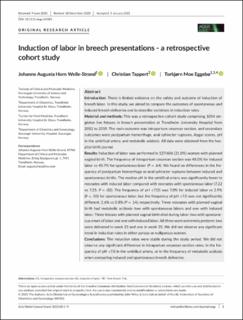| dc.contributor.author | Welle-Strand, Johanne Augusta Horn | |
| dc.contributor.author | Tappert, Christian | |
| dc.contributor.author | Eggebø, Torbjørn Moe | |
| dc.date.accessioned | 2021-10-22T07:03:01Z | |
| dc.date.available | 2021-10-22T07:03:01Z | |
| dc.date.created | 2021-05-06T20:12:47Z | |
| dc.date.issued | 2021 | |
| dc.identifier.citation | Acta Obstetricia et Gynecologica Scandinavica. 2021, 1-9. | en_US |
| dc.identifier.issn | 0001-6349 | |
| dc.identifier.uri | https://hdl.handle.net/11250/2824863 | |
| dc.description.abstract | Introduction
There is limited evidence on the safety and outcome of induction of breech labor. In this study, we aimed to compare the outcomes of spontaneous and induced breech deliveries and to describe variations in induction rates.
Material and methods
This was a retrospective cohort study comprising 1054 singleton live fetuses in breech presentation at Trondheim University Hospital from 2012 to 2019. The main outcome was intrapartum cesarean section, and secondary outcomes were postpartum hemorrhage, anal sphincter ruptures, Apgar scores, pH in the umbilical artery, and metabolic acidosis. All data were obtained from the hospital birth journal.
Results
Induction of labor was performed in 127/606 (21.0%) women with planned vaginal birth. The frequency of intrapartum cesarean section was 48.0% for induced labor vs 45.7% for spontaneous labor (P = .64). We found no differences in the frequency of postpartum hemorrhage or anal sphincter ruptures between induced and spontaneous births. The median pH in the umbilical artery was significantly lower in neonates with induced labor compared with neonates with spontaneous labor (7.22 vs 7.25; P = .02). The frequency of pH <7.05 was 7.0% for induced labor vs 2.9% (P = .05) for spontaneous labor, but the frequency of pH <7.0 was not significantly different: 2.6% vs 0.8% (P = .14), respectively. Three neonates with planned vaginal birth had metabolic acidosis: two with spontaneous labors and one with induced labor. Three fetuses with planned vaginal birth died during labor: two with spontaneous onset of labor and one with induced labor. All three were extremely preterm: two were delivered in week 23 and one in week 25. We did not observe any significant trend in induction rates in either parous or nulliparous women.
Conclusions
The induction rates were stable during the study period. We did not observe any significant difference in intrapartum cesarean section rates, in the frequency of pH <7.0 in the umbilical artery, or in the frequency of metabolic acidosis when comparing induced and spontaneous breech deliveries. | en_US |
| dc.language.iso | eng | en_US |
| dc.publisher | Wiley | en_US |
| dc.rights | Attribution-NonCommercial-NoDerivatives 4.0 Internasjonal | * |
| dc.rights.uri | http://creativecommons.org/licenses/by-nc-nd/4.0/deed.no | * |
| dc.title | Induction of labor in breech presentations - a retrospective cohort study | en_US |
| dc.type | Peer reviewed | en_US |
| dc.type | Journal article | en_US |
| dc.description.version | publishedVersion | en_US |
| dc.source.pagenumber | 1-9 | en_US |
| dc.source.journal | Acta Obstetricia et Gynecologica Scandinavica | en_US |
| dc.identifier.doi | 10.1111/aogs.14083 | |
| dc.identifier.cristin | 1908628 | |
| cristin.ispublished | true | |
| cristin.fulltext | original | |
| cristin.qualitycode | 1 | |

